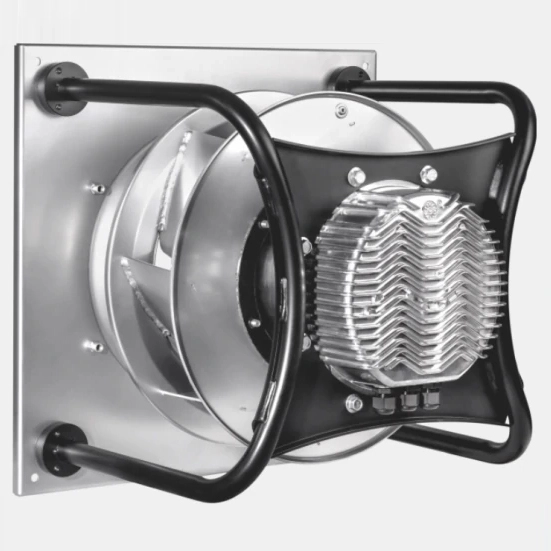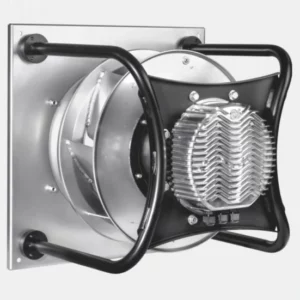Cuando se trata de sistemas de ventilación y refrigeración industriales, Dos opciones populares son los ventiladores axiales y los ventiladores radiales., específicamente ventiladores centrífugos radiales. En este articulo, Le presentaremos los ventiladores centrífugos axiales y radiales., highlighting their key characteristics and applications. Además, we will compare the two types of fans to help you understand their differences and determine which one suits your specific needs. Join us as we delve into the world of axial fans and radial centrifugal fans, shedding light on their unique features and performance.

Introducing Radial Centrifugal Fans
Radial centrifugal fans, commonly known as radial fans or centrifugal blowers, are widely used in various industries for their effective air movement capabilities. These fans operate by drawing air in through the inlet and then accelerating it radially outward using centrifugal force before discharging it through the outlet. Here are some key features and applications of radial centrifugal fans:
Design and Working Principle: Radial fans consist of a scroll-shaped housing with an impeller positioned inside. The impeller has curved blades that rotate rapidly, generating centrifugal force. As air enters the fan, it is directed towards the impeller, where the blades accelerate the air radially outward, creating pressure and airflow.
Pressure Generation: Radial centrifugal fans are particularly efficient in generating high pressures, making them suitable for applications that require significant airflow resistance, such as air conditioning systems, ventilación industrial, and combustion processes. They can handle both clean air and air with particles or dust, depending on the design and construction.
Versatilidad: Radial fans are available in various sizes, configurations, and materials to suit different applications. They can be designed for specific airflow rates, pressure requirements, and environmental conditions, offering versatility in industrial settings.
Reducción de ruido: Radial centrifugal fans are generally quieter compared to axial fans, thanks to their design and the nature of the airflow generated. This makes them suitable for applications where noise reduction is a priority, such as HVAC systems in commercial buildings or noise-sensitive environments.
Understanding Axial Fans
ventiladores axiales, also known as axial flow fans or propeller fans, are another common type of fan used for air circulation and ventilation. These fans operate by drawing air in parallel to the axis of rotation and then pushing it in the same direction. Let’s explore the key characteristics and applications of axial fans:
Design and Working Principle: Axial fans consist of a hub with multiple blades or propellers that rotate around a central axis. As the blades rotate, they create a pressure difference, causing air to flow in a linear direction. The airflow generated by axial fans is typically characterized by a high volume but relatively low pressure.
Airflow Efficiency: Axial fans are known for their high airflow efficiency, making them suitable for applications that require large volumes of air movement, such as cooling systems, ventilation in buildings, and heat exchange processes. They are effective in moving air over long distances with minimal pressure drop.
Space Efficiency: Axial fans are generally more compact compared to radial centrifugal fans, making them ideal for installations with limited space. Their slim profile and straightforward design allow for easy integration into ductwork or tight spaces.
Energy Consumption: Axial fans tend to be more energy-efficient than radial fans, especially in applications where high airflow rates are required. Their design allows for a lower power consumption per unit of airflow, resulting in cost savings over time.
Comparing Axial Fans vs. Radial Fans
Ahora, let’s compare axial fans and radial centrifugal fans based on key factors:
Airflow and Pressure: Axial fans excel in delivering high airflow volumes at low pressures, while radial centrifugal fans are designed for higher pressure applications, making them suitable for overcoming resistance in ductwork or filters.
Space and Installation: Axial fans are more compact and space-efficient, making them ideal for installations with limited space. Radial fans, por otro lado, may require more space due to their scroll housing and impeller design.
Niveles de ruido: Radial centrifugal fans are generally quieter than axial fans due to their design, making them preferred in noise-sensitive environments.
Eficiencia energética: Axial fans tend to be more energy-efficient, especially in applications where high airflow rates are required.
Axial fans and radial centrifugal fans offer unique advantages depending on the specific requirements of your application. Understanding the differences between the two types is crucial for selecting the right fan for your industrial needs. Whether you require high airflow volumes at low pressure (ventiladores axiales) or the ability to handle higher pressures and resistance (radial centrifugal fans), both options offer effective air movement solutions. Consult with a reliable fan manufacturer or supplier to determine the most suitable fan type for your specific application, ensuring optimal performance and efficiency.



